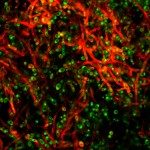Link to Pubmed [PMID] – 26503056
Nature 2015 Nov;527(7579):521-4
For more than a century, fungal pathogens and symbionts have been known to orient hyphal growth towards chemical stimuli from the host plant. However, the nature of the plant signals as well as the mechanisms underlying the chemotropic response have remained elusive. Here we show that directed growth of the soil-inhabiting plant pathogen Fusarium oxysporum towards the roots of the host tomato (Solanum lycopersicum) is triggered by the catalytic activity of secreted class III peroxidases, a family of haem-containing enzymes present in all land plants. The chemotropic response requires conserved elements of the fungal cell integrity mitogen-activated protein kinase (MAPK) cascade and the seven-pass transmembrane protein Ste2, a functional homologue of the Saccharomyces cerevisiae sex pheromone α receptor. We further show that directed hyphal growth of F. oxysporum towards nutrient sources such as sugars and amino acids is governed by a functionally distinct MAPK cascade. These results reveal a potentially conserved chemotropic mechanism in root-colonizing fungi, and suggest a new function for the fungal pheromone-sensing machinery in locating plant hosts in a complex environment such as the soil.

